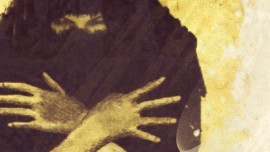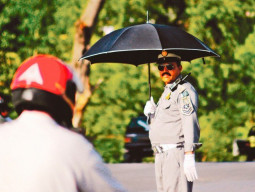
Director Baz Luhrmann, while working on an adaptation of A Midsummer’s Night Dream, happened to notice a poster for a Bollywood movie. Sufficiently intrigued, he decided to see the film. He described the experience as “high comedy, high tragedy, brother kills brother, they break out in some musical numbers, all jumbled up together in four hours of Hindi. We thought that was amazing. So our question was, ‘Could we create a cinematic form like that?’” The result was Moulin Rouge, the first unabashedly Bollywood-inspired movie, which was released in 2001.
The movie industries of Mumbai and Los Angeles have had symbiotic relationships, with Bollywood borrowing storylines and now sometimes actors from Hollywood. It is in the field of fashion that India has had the most striking impact. Western celebrities have always had a fascination with Indian designs — dating back to the 60s when wearing clothing indigenous to India was seen as a political statement, a reflection of ‘deep spirituality’ and a way to reject the consumerism of the West. From The Beatles wearing dhotis at the Maharishi Mahesh Yogi’s retreat to the popularity of the Nehru jacket, Indian-inspired clothing was meant to be about more than the clothes. But it just wasn’t very fashionable.
There was one exception though: the sartorial sleekness of the sari. Hollywood actress Goldie Hawn, herself under the influence of Eastern mysticism, was the first celebrity, back in the 1970s, to consistently sport a sari. At the time she was the only one. In the last few years, however, many celebrities, from Hollywood, the music industry and even the sporting world, have been photographed at premieres, parties and events wearing the sari with style, élan and confidence.
The story of the sari and its growing popularity in the West is the story of India and its rise as a world power.
As India experienced unprecedented economic growth throughout the 1990s and into the new century, the country began looking outwards. Its movie industry and fashion designers began showcasing their work abroad. Naturally, Western designers, always on the lookout for new inspiration, began incorporating the sari into their collections. British designer Stella McCartney has been the most vociferous advocate of the sari, saying, “In the fickle world of fashion, the sari will always endure.”
Among the Hollywood stars who have been photographed wearing the sari are Angelina Jolie, Cameron Diaz and even Dame Helen Mirren. Even Julia Roberts was seen in a stunning sari, along with a bindi and payal, in her latest movie, Eat Pray Love. Tennis stars like Anna Kournikova, Maria Kirilenko and the Williams sisters have also proudly sported the stylish South Asian garment. British model and actress Elizabeth Hurley has been seen in a sari more than any other Western celebrity, perhaps as a result of her marriage to Indian millionaire Arun Nayar. In addition to the sari, No Doubt vocalist Gwen Stefani has often been seen in a bindi while Madonna favours applying mehndi to her hands.
Then, there is the growing power and influence of the NRIs. Not only do fashion designers have to cater to this demographic, many are NRIs themselves. Anjula Acharia-Bath, for example, is the CEO of Desi Hits, a multimedia company that, among other things, dresses the stars. It was Bath who got music group The Pussycat Dolls, who had just done a cover version of AR Rahman’s “Jai Ho”, to dress in saris. It must be said, though, that the Dolls killed the elegance of the sari by wearing it more like bikinis. Indian-born designer Alpana Bawa, who is now settled in New York, is known for her brightly-coloured saris and has dressed Erykah Badu, Lauren Dern and other celebrities in the garment.
India’s growing relevance on the global stage has also made the country a must-visit for celebrities on promotional tours, charity events and even as performers for “item” numbers in Bollywood films. And as the saying goes, “When in Rome, do as the Romans do.” From Bo Derek and Beyonce to Serena and Venus Williams, all have worn the traditional Indian sari while in the country.
Even though the sari dates back to 3000 BC, it remains as timely as ever today. With globalisation leading to new experimentation with indigenous designs, the sari will continue to grow, evolve and be worn by even more starlets in the years and decades to come.
Published in The Express Tribune, October 3rd, 2010.






































COMMENTS (2)
Comments are moderated and generally will be posted if they are on-topic and not abusive.
For more information, please see our Comments FAQ